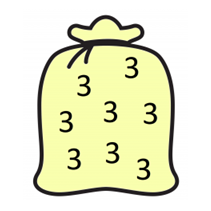
The Domesday Project
Take a look at these data collected by children in 1986 as part of the Domesday Project. What do they tell you? What do you think about the way they are presented?

Take a look at these data collected by children in 1986 as part of the Domesday Project. What do they tell you? What do you think about the way they are presented?
Looking at the Olympic Medal table, can you see how the data is organised? Could the results be presented differently to give another nation the top place?
What happens when you add three numbers together? Will your answer be odd or even? How do you know?
Look at some of the results from the Olympic Games in the past. How do you compare if you try some similar activities?

Amy has a box containing domino pieces but she does not think it is a complete set. Which of her domino pieces are missing?
These clocks have only one hand, but can you work out what time they are showing from the information?
What does the overlap of these two shapes look like? Try picturing it in your head and then use some cut-out shapes to test your prediction.
What shape is the overlap when you slide one of these shapes half way across another? Can you picture it in your head? Use the interactivity to check your visualisation.
On a digital clock showing 24 hour time, over a whole day, how many times does a 5 appear? Is it the same number for a 12 hour clock over a whole day?